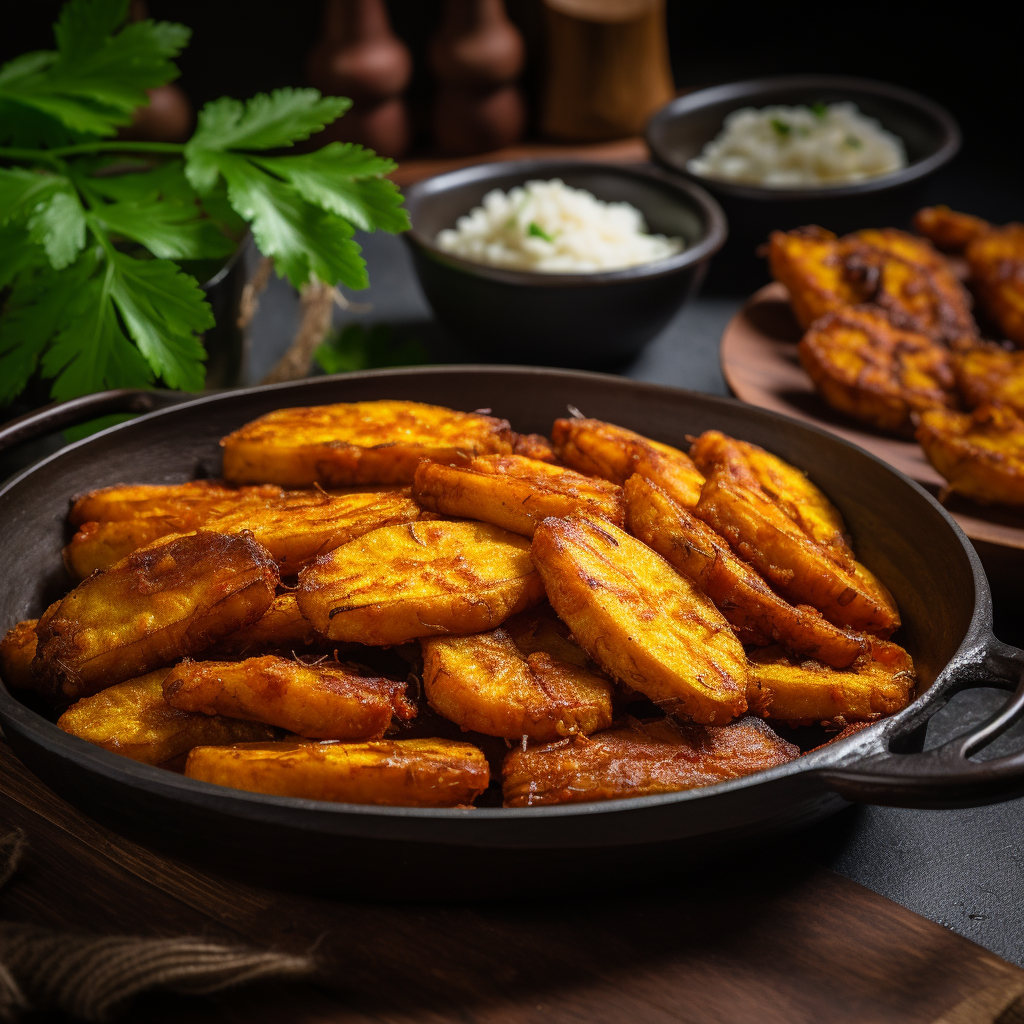Introduction to Aloco: A traditional dish from Ivory Coast
Aloco, a traditional dish from Ivory Coast, is a delightful blend of plantains and spices that is sure to tantalize your taste buds. This mouthwatering recipe has deep roots in the country’s rich culinary history and holds great cultural significance. The combination of the sweet and savory flavors in Aloco makes it a favorite among locals and tourists alike. In this article, we will explore the history and cultural significance of Aloco, the ingredients and quantities needed for an authentic recipe, a step-by-step guide to preparing Aloco, variations of the dish, serving suggestions, health benefits of its main ingredients, where to find Aloco in Ivory Coast and beyond, and some tips and tricks for perfecting your own Aloco recipe.
The history and cultural significance of Aloco in Ivory Coast
Aloco has a long history in Ivory Coast and is deeply rooted in the country’s culinary traditions. It is believed to have originated in the southern regions of the country, where plantains are abundant. The dish has been passed down through generations, with each family adding their own unique twist to the recipe. Aloco is often served during special occasions, such as weddings and festivals, and is a symbol of community and togetherness.

The cultural significance of Aloco extends beyond its role as a delicious dish. It is a representation of the country’s rich cultural heritage and the importance of food in Ivorian society. The preparation of Aloco often involves the entire family, with each member contributing to different steps of the cooking process. This communal approach to cooking and sharing meals reflects the strong sense of community and generosity that is deeply ingrained in Ivorian culture.
Ingredients and quantities for an authentic Aloco recipe
To prepare an authentic Aloco recipe, you will need the following ingredients:
- 4 ripe plantains
- 1 cup of vegetable oil
- 1 onion, finely chopped
- 2 cloves of garlic, minced
- 1 teaspoon of ginger, grated
- 1 teaspoon of paprika
- Salt and pepper to taste
These quantities are for a basic Aloco recipe, but feel free to adjust them based on your personal preferences. The plantains should be ripe but firm, as they will provide the perfect balance of sweetness and texture to the dish. The onion, garlic, and ginger add a depth of flavor, while the paprika, salt, and pepper enhance the overall taste profile.
Step-by-step guide to preparing Aloco
- Start by peeling the plantains and cutting them into thick slices.
- Heat the vegetable oil in a deep frying pan or pot over medium heat.
- Once the oil is hot, carefully add the plantain slices and fry them until they turn golden brown on both sides. This should take about 5 minutes.
- Remove the plantains from the oil and place them on a paper towel-lined plate to drain excess oil.
- In a separate pan, heat a tablespoon of vegetable oil and sauté the chopped onion, minced garlic, and grated ginger until they become fragrant and slightly caramelized.
- Add the fried plantains to the pan and sprinkle them with paprika, salt, and pepper. Gently toss everything together to ensure the flavors are evenly distributed.
- Cook for an additional 2-3 minutes, until the plantains are well coated with the spice mixture.
- Remove from heat and serve hot.

Variations of Aloco: Adding your own twist to the recipe
While the authentic Aloco recipe is delicious on its own, you can also add your own twist to the dish to create unique flavor combinations. Here are a few variations to consider:
- Spicy Aloco: If you enjoy a bit of heat, add some chopped chili peppers or a dash of cayenne pepper to the spice mixture.
- Sweet and Savory Aloco: Sprinkle the fried plantains with a pinch of cinnamon and drizzle them with honey or maple syrup for a sweet and savory twist.
- Coconut Aloco: Replace the vegetable oil with coconut oil for a subtle coconut flavor that pairs well with the plantains.
- Herb-infused Aloco: Add fresh herbs like thyme or rosemary to the sautéed onion, garlic, and ginger for an aromatic twist.
Feel free to experiment with different ingredients and flavors to create your own signature Aloco recipe.
Serving suggestions and accompaniments for Aloco
Aloco can be enjoyed as a standalone dish or served as a side alongside other Ivorian delicacies. Here are a few serving suggestions and accompaniments to consider:
- Serve Aloco with grilled meat or fish for a complete and satisfying meal.
- Pair it with a fresh salad or steamed vegetables for a balanced and nutritious option.
- Top Aloco with a dollop of sour cream or yogurt for a creamy and tangy contrast.
- Enjoy it with a side of spicy tomato sauce or a squeeze of fresh lime juice for an extra burst of flavor.
Aloco is a versatile dish that complements a wide range of flavors and cuisines, so feel free to get creative with your accompaniments.
Health benefits of Aloco’s main ingredients
Aloco not only delights the taste buds but also offers several health benefits due to its main ingredients. Plantains, the star ingredient of Aloco, are a rich source of dietary fiber, vitamins A and C, and potassium. They promote healthy digestion, boost the immune system, and help regulate blood pressure. Additionally, plantains are low in fat and cholesterol, making them a healthy alternative to traditional fried snacks.
The spices used in Aloco, such as ginger and paprika, also offer numerous health benefits. Ginger has anti-inflammatory properties and aids in digestion, while paprika is rich in antioxidants and can help improve blood circulation. By incorporating these ingredients into your diet through Aloco, you can enjoy a delicious meal while reaping the nutritional benefits.
Where to find Aloco in Ivory Coast and beyond
If you find yourself in Ivory Coast, Aloco can be found in local restaurants, street food stalls, and markets throughout the country. It is a staple dish in Ivorian cuisine and is widely available. Be sure to try Aloco at different locations to experience the subtle variations in flavor and preparation methods.
If you’re not in Ivory Coast, you can still enjoy Aloco by preparing it in your own kitchen. The ingredients required for an authentic recipe are readily available in most grocery stores, making it easy to recreate this delightful dish no matter where you are in the world.
Tips and tricks for perfecting your Aloco recipe
To ensure your Aloco turns out perfectly every time, here are a few tips and tricks to keep in mind:
- Use ripe but firm plantains for the best texture and flavor.
- Be cautious when frying the plantains to avoid burning them. Adjust the heat as needed and keep a close eye on them.
- Drain the fried plantains on a paper towel-lined plate to remove excess oil and keep them crispy.
- Adjust the seasoning according to your taste preferences. Feel free to add more spices or salt and pepper as desired.
- Serve Aloco immediately after cooking to enjoy it at its best.
By following these tips, you can elevate your Aloco recipe and impress your family and friends with a delicious and authentic Ivorian dish.

Conclusion: Embrace the flavors of Ivory Coast with Aloco
Aloco is more than just a dish; it is a representation of the vibrant culture and culinary traditions of Ivory Coast. By discovering and preparing an authentic Aloco recipe, you can immerse yourself in the flavors and aromas of this West African nation. Whether you enjoy it as a standalone dish or alongside other Ivorian delicacies, Aloco is sure to leave a lasting impression on your taste buds. So, gather your ingredients, follow the step-by-step guide, and embark on a culinary journey to Ivory Coast with Aloco.
Note: This article is for informational purposes only. Please consult a healthcare professional or nutritionist for personalized dietary advice.
